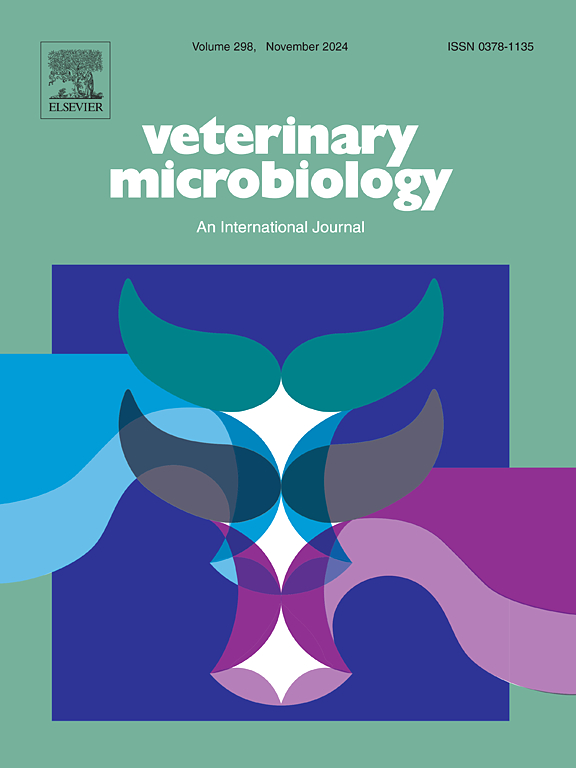TGEV-M up-regulates ATP5D to promote mPTP opening via inhibiting BIRC6-236aa encoded by circBIRC6-2
IF 2.4
2区 农林科学
Q3 MICROBIOLOGY
引用次数: 0
Abstract
Transmissible gastroenteritis virus (TGEV) infection can down-regulate circBIRC6–2 expression and induce mitochondrial permeability transition pore (mPTP) opening abnormally. BIRC6–236aa, encoded by circBIRC6–2, can suppress mPTP opening by interacting with VDAC1. However, the molecular mechanism of circBIRC6–2 downregulation by TGEV infection is unsuspected, and it is unclear that whether BIRC6–236aa can inhibit mPTP opening by post translational modifications (PTM) and downstream regulatory proteins. In this study, we found that TGEV membrane protein (TGEV-M) can suppress circBIRC6–2 expression by interacting with heterogeneous nuclear ribonucleoprotein A1 (hnRNPA1) and inhibiting the translocation of hnRNPA1, which can bind to baculoviral IAP repeat containing 6 (birc6) pre-mRNA to promote the formation of circBIRC6–2. In addition, glycogen synthase kinase-3 beta (GSK-3β) can phosphorylate Ser180 of BIRC6–236aa, and phosphorylated-BIRC6–236aa (p-BIRC6–236aa) can inhibit mPTP opening. 271 differential expression proteins (DEPs) were identified after overexpression of BIRC6–236aa. ATP synthase, H+ transporting, mitochondrial F1 complex, delta subunit (ATP5D, also named ATP5F1D), one of the DEPs was down-regulated in response to BIRC6–236aa, and ATP5D can promote mPTP opening induced by TGEV. In conclusion, TGEV-M can suppress the expression of circBIRC6–2 through targeting hnRNPA1. The Ser180 of BIRC6–236aa encoded by circBIRC6–2 can be phosphorylated by GSK-3β, and p-BIRC6–236aa can inhibit mPTP opening by down-regulating ATP5D expression.
TGEV-M通过抑制circBIRC6-2编码的BIRC6-236aa,上调ATP5D,促进mPTP打开
传染性胃肠炎病毒(TGEV)感染可下调cirbirc6 - 2表达,诱导线粒体通透性过渡孔(mPTP)异常开放。BIRC6-236aa由circBIRC6-2编码,通过与VDAC1相互作用抑制mPTP打开。然而,感染TGEV后cirbirc6 - 2下调的分子机制尚不清楚,BIRC6-236aa是否可以通过翻译后修饰(PTM)和下游调节蛋白抑制mPTP打开。在本研究中,我们发现TGEV膜蛋白(TGEV- m)通过与异质核核糖核蛋白A1 (hnRNPA1)相互作用,抑制hnRNPA1的易位,从而抑制circBIRC6-2的表达,而hnRNPA1可以结合到含有6 (birc6) pre-mRNA的杆状病毒IAP repeat上,促进circBIRC6-2的形成。此外,糖原合成酶激酶3β (GSK-3β)可磷酸化BIRC6-236aa的Ser180,磷酸化的BIRC6-236aa (p-BIRC6-236aa)可抑制mPTP的开放。BIRC6-236aa过表达后鉴定出271个差异表达蛋白(DEPs)。ATP合成酶、H+转运、线粒体F1复合体、delta亚基(ATP5D,又称ATP5F1D),其中一种DEPs响应BIRC6-236aa下调,ATP5D可促进TGEV诱导的mPTP开放。综上所述,TGEV-M可以通过靶向hnRNPA1抑制cirbirc6 - 2的表达。circirc6 - 2编码BIRC6-236aa的Ser180可被GSK-3β磷酸化,p-BIRC6-236aa可通过下调ATP5D表达抑制mPTP开放。
本文章由计算机程序翻译,如有差异,请以英文原文为准。
求助全文
约1分钟内获得全文
求助全文
来源期刊

Veterinary microbiology
农林科学-兽医学
CiteScore
5.90
自引率
6.10%
发文量
221
审稿时长
52 days
期刊介绍:
Veterinary Microbiology is concerned with microbial (bacterial, fungal, viral) diseases of domesticated vertebrate animals (livestock, companion animals, fur-bearing animals, game, poultry, fish) that supply food, other useful products or companionship. In addition, Microbial diseases of wild animals living in captivity, or as members of the feral fauna will also be considered if the infections are of interest because of their interrelation with humans (zoonoses) and/or domestic animals. Studies of antimicrobial resistance are also included, provided that the results represent a substantial advance in knowledge. Authors are strongly encouraged to read - prior to submission - the Editorials (''Scope or cope'' and ''Scope or cope II'') published previously in the journal. The Editors reserve the right to suggest submission to another journal for those papers which they feel would be more appropriate for consideration by that journal.
Original research papers of high quality and novelty on aspects of control, host response, molecular biology, pathogenesis, prevention, and treatment of microbial diseases of animals are published. Papers dealing primarily with immunology, epidemiology, molecular biology and antiviral or microbial agents will only be considered if they demonstrate a clear impact on a disease. Papers focusing solely on diagnostic techniques (such as another PCR protocol or ELISA) will not be published - focus should be on a microorganism and not on a particular technique. Papers only reporting microbial sequences, transcriptomics data, or proteomics data will not be considered unless the results represent a substantial advance in knowledge.
Drug trial papers will be considered if they have general application or significance. Papers on the identification of microorganisms will also be considered, but detailed taxonomic studies do not fall within the scope of the journal. Case reports will not be published, unless they have general application or contain novel aspects. Papers of geographically limited interest, which repeat what had been established elsewhere will not be considered. The readership of the journal is global.
 求助内容:
求助内容: 应助结果提醒方式:
应助结果提醒方式:


